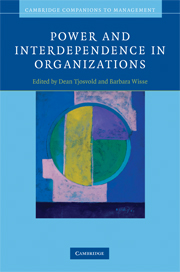Book contents
- Frontmatter
- Contents
- List of figures
- List of tables
- Foreword
- Introduction
- I Relationships to manage the faces of power
- II Participative leadership: Leading with others
- III Exchange dynamics and outcomes
- IV Power to influence
- 12 Power and the interpersonal influence of leaders
- 13 Bases of leader power and effectiveness
- 14 Power tactics preference in organizations: Individual and situational factors
- 15 Influence triggers and compliance: A discussion of the effects of power, motivation, resistance, and antecedents
- 16 Leadership and conflict: Using power to manage conflict in groups for better rather than worse
- 17 Organizational change
- V Leading with values
- Index
- References
16 - Leadership and conflict: Using power to manage conflict in groups for better rather than worse
Published online by Cambridge University Press: 19 January 2010
- Frontmatter
- Contents
- List of figures
- List of tables
- Foreword
- Introduction
- I Relationships to manage the faces of power
- II Participative leadership: Leading with others
- III Exchange dynamics and outcomes
- IV Power to influence
- 12 Power and the interpersonal influence of leaders
- 13 Bases of leader power and effectiveness
- 14 Power tactics preference in organizations: Individual and situational factors
- 15 Influence triggers and compliance: A discussion of the effects of power, motivation, resistance, and antecedents
- 16 Leadership and conflict: Using power to manage conflict in groups for better rather than worse
- 17 Organizational change
- V Leading with values
- Index
- References
Summary
Introduction
One of the greatest challenges for leaders is to use their power in ways that effectively manage conflict. Conflict pervades the life of all groups. Sometimes, conflict benefits the group and its members by providing new information and helping members to see new ways of thinking about their work. However, conflict also typically feels uncomfortable and may be interpreted as a personal attack or a personality clash, even when it benefits the quality of a group's decision-making. The challenge for team leaders is, therefore, to exercise power in a way that promotes the potential information-processing benefits of conflict while minimizing the relationship risks associated with expressions of power to resolve conflict. To achieve this, we argue that leaders are more likely to lead their groups to better performance with indirect expressions of power such as managing group process rather than outcomes, because indirect expressions of power are both less likely to elicit reactance on the part of the team members and more likely to create a sense of psychological safety between leaders and followers.
Anyone who has worked in a team – from an amateur sports team to a community task force to a professional consulting team – will have experienced some amount of conflict. Conflict is inevitable in group life because people have different backgrounds, experiences, values, personalities and ideas that cannot help but influence the way that members interact with each other.
- Type
- Chapter
- Information
- Power and Interdependence in Organizations , pp. 281 - 298Publisher: Cambridge University PressPrint publication year: 2009
References
- 6
- Cited by



